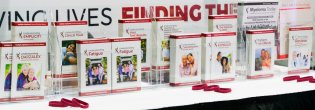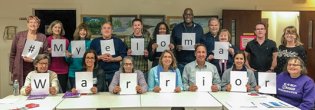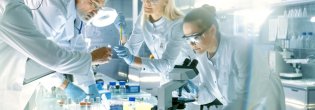What Is Autologous Stem Cell Transplant (or Bone Marrow Transplant)?
The standard of care for fit multiple myeloma patients is to receive high-dose chemotherapy (HDT) with autologous stem cell rescue. This procedure is also known as autologous stem cell transplant (ASCT). Autologous stem cell transplant can provide a deep response with long-term remission. A deep response, having no minimal residual disease (MRD), also known as MRD-negative, improves outcomes and survival.
Autologous vs. Allogeneic
"Autologous" refers to the blood-making stem cells harvested from the patient to be a source of new blood cells after high-dose chemotherapy with melphalan. "Allogeneic" transplant is when a donor’s stem cells are used instead of the patient's own cells. Allogeneic transplants are recommended in the context of a clinical trial. To learn more about allogeneic transplants, refer to the IMF Publication on Understanding Stem Cell Transplant in Myeloma.
Consult with an Expert
Myeloma is a very individualized disease. Do NOT compare your myeloma to that of other patients. Each case of myeloma is unique, and each patient’s myeloma has its own characteristics. This is why it is so important to seek an opinion — or second opinion — from an experienced myeloma specialist.
Please note that myeloma experts have yet to agree on which patients will most benefit from an autologous stem cell transplant. Therefore, general statements about patient outcomes both during and after ASCT are not appropriate.
Even if you are a suitable candidate for ASCT, the decision to undergo this procedure is yours.
Why Is Autologous Stem Cell Transplant (ASCT) Used in Myeloma Patients?
People with myeloma must have as many short- and long-term treatment options available to them as possible. More treatment options increase the likelihood of attaining a deep and durable response.
ASCT is just one option for myeloma patients to consider. It is the most common type of transplant used for eligible myeloma patients.
Gain a better understanding of ASCT
With ASCT, myeloma patients receive high-dose therapy (HDT) with stem cell rescue. Healthy blood cells originate in the bone marrow. Myeloma cells also originate in the same bone marrow microenvironment as the normal blood cells. As myeloma cells build up in the bone marrow, they become intermixed with normal blood stem cells. These stem cells produce red blood cells (RBCs), white blood cells (WBCs), and platelets.
HDT is more effective at ridding myeloma cells from the bone marrow than standard-dose chemotherapy. Yet, any treatment that reaches the bone marrow to kill myeloma cells may also damage your normal blood-making stem cells. With reduced bone marrow, your body is less able
- to produce blood cells that carry oxygen into organs and tissues (RBCs)
- to help your blood to clot (platelets)
- to defend against infection (WBCs).
Why ASCT is considered a stem cell transplant and not a bone marrow transplant
In the ASCT procedure, your peripheral blood stem cells (PBSC) are first collected (also known as harvested) from circulating blood. This process occurs after a mobilizing agent triggers the release of bone marrow stem cells into the bloodstream. After HDT has been given, your harvested stem cells are reinfused (also known as transplanted) into you. Thereby, these healthy harvested stem cells “rescue” your bone marrow from the effects of HDT.
What Must You Consider Before Deciding to Undergo an ASCT?
- Discuss the benefits and risks of an ASCT and other treatment options with your doctor.
- ASCT can improve the depth of response and duration (length) of remission. This is known as progression-free survival (PFS). Before harvesting normal blood stem cells, doctors usually require at least 50% reduction in levels of monoclonal protein (myeloma protein, M-protein) and other indicators.
- It is important to note that rates of PFS may improve with ASCT. Yet, rates of overall survival (OS) remain the same with or without transplant.
- Some patients will reach minimal residual disease negativity (MRD-) after receiving treatment, with or without transplant. People who reach MRD- will likely have improved outcomes even without transplant. Early ASCT produces higher rates of sustained PFS and MRD-negative status.
- Quality of life (QOL) and overall costs of treatment favor early ASCT.
- Ask your doctor to explain the proposed treatment plan for myeloma. If early transplant not part of the plan, discuss with your doctor the option of harvesting your stem cells and freezing them for future use. This option will allow for a delayed ASCT.
How Do You Know If You Are Eligible for a Stem Cell Transplant?
In the U.S., eligibility criteria for ASCT varies among institutions. In 2014, the IMF’s International Myeloma Working Group (IMWG) published a consensus statement. This statement found that age 65 is no longer a suitable criterion to determine a patient's eligibility for ASCT. Physiologic age is a more crucial factor than chronological age. Yet, this does not mean that age is not a factor at all. Your general fitness and any concurrent illnesses also help determine appropriate treatment.
In the U.S., there is no upper age limit set in the Medicare National Coverage Determination for ASCT in myeloma. Also, the Centers for Medicare & Medicaid Services (CMS) have now removed the upper age limit on coverage. Therefore, determining if a patient is eligible for ASCT is up to the patient’s doctor and the Medicare administrative contractor within the patient’s jurisdiction. Visit cms.gov/Medicare/Coverage/DeterminationProcess for more information or speak with your healthcare team.
While ASCT is an option for most myeloma patients upon completion of frontline therapy, not all patients are candidates for this intensive approach. Decisions regarding transplant should be made based on a risk-benefit assessment, as well as the needs and wishes of the patient.
You and your doctor must consider all the relevant myeloma-related factors and patient-related factors.
Myeloma-related factors to discuss with your doctor:
- the stage of disease
- level of aggressiveness
- response to prior treatments,
- chromosomal abnormalities
Patient-related factors to discuss with your doctor:
- age
- general physical condition
- the presence of other medical conditions
- Organ function (kidney, liver, lung, heart)
- Personal preference
- Family and work situation
What Must You Discuss with Your Doctor Before Undergoing an ASCT?
- Confirm your diagnosis of myeloma and that your myeloma is active and that it requires treatment. If there is any doubt, seek an opinion from a myeloma expert before moving ahead. Discuss with your doctor the treatment strategy best for you.
- After each cycle of initial therapy (usually every 3 to 4 weeks), ask your doctor about your response to treatment. Learn to understand the test results and how the myeloma is responding, including bone marrow testing and imaging studies. If the myeloma is not responding well to therapy, a change in therapy may be needed before proceeding to an ASCT.
- Ask your doctor if you may run the risk of serious complications and if another treatment option would be safer with equal benefit.
When Should You Plan to Undergo an ASCT?
When to perform ASCT is an important and personal decision.
ASCT may be performed
- as part of a frontline therapy regimen or
- at the time of myeloma relapse.
Most transplant doctors believe that it is better to perform ASCT early in the disease course. Yet, evidence also shows that if a patient has a deep response to initial therapy, stem cells can be collected and frozen. In this scenario, the ASCT can be delayed until relapse. Discuss your optimal timing for an ASCT with your doctor.
Before Undergoing an ASCT, When Should One Begin Chemotherapy?
The initial therapy before ASCT should be with drugs that do not damage your normal stem cells before harvesting takes place. Use of alkylating agents is less common as part of initial therapy and should be avoided if ASCT is being considered. These agents can lead to damage of normal stem cells.
Ask your doctor if any of the regimens being considered might reduce your success of harvesting healthy blood stem cells for ASCT. For example, therapy with Revlimid® (lenalidomide) for more than 4 cycles or too close to the time of stem cell harvesting may impair stem cell collection.
How Should You Prepare Yourself for an ASCT?
After you review this webpage, read the complete Understanding Stem Cell Transplant in Myeloma booklet. Also explore the IMF’s library of publications about the therapies used for the treatment of myeloma at every stage of the disease. All are free of charge and can be downloaded or requested in printed form.
You should feel comfortable and reassured before you begin your ASCT process.
Be empowered to ask your doctor any questions you may have. Some transplant centers may even pair you with a fellow patient who has been through the ASCT process. That fellow patient may share a firsthand account of their experience. If possible, bring a friend or a family member to your doctor’s appointment, or be available by phone, to help take notes. If available, ask your doctor to provide a printed “after-visit summary.” Share what you learn with your loved ones so that they know what to expect.
Your transplant center and team
Here are some things to do before you undergo your transplant:
- Ask your doctor whether you will receive treatment on an inpatient or outpatient basis.
- Visit the transplant center and see the rooms where the ASCT procedure and recovery would take place.
- If the transplant center location is far from your home, understand lodging options where you can stay. Many transplant centers have lodging options nearby or can help you find suitable accommodations.
- Ask to meet your myeloma transplant team in advance. This team may include doctors, nurses, social workers, psychologists, and allied healthcare professionals.
- Arrange care partner support for during and following the transplant process. Learn more with these Care Partner Resources.
- You and your care partner(s) will need to work with your employer to arrange time off work and complete any necessary Family Medical Leave Act (FMLA) paperwork.
Support resources
ASCT can cause overwhelming stress on patients and their loved ones before, during, and after the procedure. Physical, psychological, emotional, and financial stressorss may trigger feelings of anxiety, depression, or anger. That is why it is important to have a strong support network. We urge you to take advantage of the support resources offered through your hospital, the IMF’s InfoLine, support groups network, and other patient-centric organizations. Ask your doctor about the benefits of psychological counseling or psychiatric consultation for you and your care partner.
What Is the Process of ASCT in Multiple Myeloma?
Induction therapy
Myeloma patients have many options for induction therapy prior to ASCT, including the following:
- Velcade® (bortezomib), Revlimid, and dexamethasone (VRd)
- VRd may be the most common regimen used in myeloma.
- VRd was studied in the IFM and DETERMINATION clinical trials.
- Darzalex® (daratumumab) with VRd (D-VRd) was evaluated vs. VRd in newly diagnosed transplant-eligible patients with myeloma in the GRIFFIN clinical trial.
- After two years of maintenance therapy, the final analysis showed that D-VRd resulted in higher stringent complete response rates and MRD-negativity.
- Kyprolis® (carfilzomib), Revlimid, and dexamethasone (KRd) has been used and studied before and after ASCT.
- The FORTE clinical trial demonstrated high efficacy with a favorable safety profile of KRd with ASCT in newly diagnosed myeloma patients.
- Darzalex and KRd (D-KRd) is a four-drug combination being used more frequently now.
- Clinical data has shown that the D-KRd induction regimen is both safe and yields deep responses prior to ASCT.
- This regimen can lead to a high rate of MRD negativity in newly diagnosed myeloma patients after ASCT.
In addition, the National Comprehensive Cancer Network® (NCCN®) list these other treatment options:
- Revlimid and dexamethasone (Rd),
- Velcade, cyclophosphamide, and dexamethasone (VCd or CyBorD),
- Velcade, Adriamycin® (doxorubicin), and dexamethasone (PAd),
- Ninlaro® (ixazomib), Revlimid (lenalidomide), and dexamethasone (IRd).
The NCCN also lists the following options as useful in certain circumstances:
- Velcade and dexamethasone (Vd),
- Velcade, thalidomide, and dexamethasone (VTd),
- Darzalex and VTd (D-VTd),
- VTd, cisplatin, doxorubicin, cyclophosphamide, and etoposide (VTd-PACE).
What Is Apheresis?
To prevent damage of healthy blood stem cells in the bone marrow, the stem cells are harvested before treating with an alkylating agent such as melphalan. Stem cells are collected through a process called apheresis. Blood is taken from the patient, either through a peripheral IV or a central venous catheter, and is passed through a special machine to separate the stem cells from other blood components. The other blood components are returned to the patient.
Apheresis is usually done as an outpatient procedure for 1 to 5 days, lasting from 3 to 4 hours each day.
What Are the Steps Taken Before Harvesting a Person’s Stem Cells?
Protocol 1:
A) Beginning four days before stem cell collection, the patient receives subcutaneous (SQ) injections with a colony-stimulating factor (CSF) to mobilize stem cells from the bone marrow into the bloodstream.
B) Stem cells are harvested daily until the goal for collection is reached. Typically, the aim is to harvest enough stem cells for two transplants. The amount of stem cells reinfused into the patient impacts the recovery of the patient’s blood cell counts.
Protocol 2:
A) The patient receives both CSF and chemotherapy.*
B) Ater chemotherapy is completed, a WBC growth factor is given daily by injection for approximately 10 days.
C) The stem cells are harvested over 2 to 5 days, while the patient is still receiving growth factor injections.
*Note: Ask your doctor to explain the potential benefits and side effects of using chemotherapy in addition to growth factors. The most used drug to enhance the release of stem cells from the bone marrow into the bloodstream is cyclophosphamide. Yet, other drugs may be used instead.
An advantage of cyclophosphamide is that it is also used to treat myeloma. However, it usually requires hospitalization while stem cell production is being stimulated. A disadvantage of cyclophosphamide is that it lowers WBC count. As a result, patients may acquire infections and be hospitalized longer.
Protocol 3:
A)The patient receives CSF to mobilize stem cells plus another medication to release stem cells into the peripheral blood.*
Regardless of the way stem cells are mobilized, the collected stem cells are taken to a processing laboratory, where they are cryopreserved in dimethyl sulfoxide (DMSO) and frozen in liquid nitrogen, stored at a temperature of –80°C (–112°F). The cells are available for later use within days, weeks, or years. Excellent function of stem cells is retained for at least 10 years. Scientific evidence shows that “purging” myeloma cells from the harvested stem cells is not effective in ASCT for myeloma.
*Note: In 2008, the FDA approved Mozobil® (plerixafor) for stem cell mobilization in combination with a growth factor. CSF injections begin 4 days before stem cell collection begins, then, Mozobil is injected under the skin approximately 11 hours before the start of apheresis. Mozobil is particularly helpful for patients who have difficulty generating enough stem cells for harvesting. Fewer apheresis procedures and reduced number of days on the apheresis machine are expected. In September 2023, the FDA approved Aphexda™ (motixafortide) to mobilize hematopoietic stem cells for ASCT. One dosage of Aphexda with filgrastim enabled most myeloma patients in the clinical trial to achieve the collection goal of ≥ 6 million hematopoietic stem cells.
What Is the Process Once a Patient Can Proceed with ASCT?
High-dose therapy
When it is time to proceed with ASCT, high-dose chemotherapy will be given as treatment to irradicate myeloma cells. This type of therapy destroys myeloma cells in the bone marrow where they grow. However, normal cells are also destroyed. The most commonly used medication for myeloma is melphalan given at high dose as an IV approximately 2 days before stem cells are reinfused.
Medications are given to prevent or lessen the anticipated side effects of high-dose therapy
Common side effects of high-dose therapy include
- nausea
- vomiting
- diarrhea
- mouth sores
- skin rashes
- hair loss
- fever or chills
- infection
During and after high-dose therapy, Patients are monitored very closely. Their team will take the daily measurement of weight, blood pressure, heart rate, and temperature.
Stem cell rescue
Approximately 36 to 48 hours after the high-dose therapy is administered, the levels of melphalan in your blood and tissue are very low. This allows the cells to be safely reinfused back into your bloodstream through a catheter. Each bag of frozen stem cells are thawed in a warm water bath and reinfused back into your bloodstream over 1 to 4 hours. The chemical used to preserve the stem cells, DMSO, has a garlic smell. You may even experience the taste of garlic.
Engraftment
When the reinfused stem cells migrate from the bloodstream to your bone marrow, they begin to produce new blood cells. These new blood cells replace the normal stem cells that the high-dose therapy destroyed. This process is known as engraftment.
You may receive subcutaneous injections of growth factors. These growth factors will help stimulate your bone marrow to produce normal blood cells. Your stem cells will begin to grow back within 10 to 14 days after reinfusion, allowing your blood counts to recover. You may receive transfusions if necessary.
Hospital stays during engraftment
Some transplant centers may require you to remain in the hospital after the reinfusion on an inpatient basis. Some centers have facilities nearby where you may stay while being monitored daily at the hospital on an outpatient basis. If you live near the transplant center, you may be able to sleep at home and come back to the hospital for daily monitoring on an outpatient basis. The length of stay in the hospital or at a nearby facility varies from patient to patient but is usually around 2 to 3 weeks.
What Is Recovery Like After the ASCT Procedure?
When you are discharged, your recovery will continue at home for about two to four months. Often, the most difficult time is waiting for the reinfused stem cells to engraft, for blood counts to return to safe levels, and for side effects to resolve. On some days, you may feel better. On other days, you may feel too weak to do much more than sleep.
Recovery may feel like a rollercoaster ride. Frequent visits to the hospital may be required to monitor your progress. It is important to take things one day at a time. As your bone marrow produces new blood cells:
- symptoms resolve
- the risk of serious infections is reduced
- transfusions may no longer be needed
What Are Some Possible Side Effects of ASCT?
Side effects are a possibility with every type of medical treatment or procedure. Each patient reacts differently at each step of the ASCT process. No two patients share the same side-effect profile.
The most common potential side effects following high-dose therapy with stem cell rescue are:
- nausea
- mouth sores
- hair loss
- Infection
- fatigue
In part, the appropriate management of side effects is why it is so important to have your ASCT performed at a transplant center. Your transplant center team is more likely to have the expertise to care for your individual needs.
As a result of the high-dose therapy, bone marrow function stops which causes low blood counts. Many patients will need to receive transfusion of platelets to reduce the risk of bleeding and red blood cells to treat anemia.
Until engraftment of the reinfused stem cells takes place, patients are very susceptible to developing infections. These infections can cause serious complications and even be potentially life-threatening. The body’s immune system is weakened by high-dose therapy and its effects. So, even a minor infection like the common cold can lead to serious complications.
What Are Precautions Myeloma Patients Should Take During Recovery from ASCT?
To protect the patient and prevent infection, the following supportive care measures may be required:
- Antibiotics may be prescribed to help prevent infection.
- Visitors may be asked to wash their hands.
- Visitors may be asked to wear masks and rubber gloves.
- Fresh fruits, vegetables, and flowers may be prohibited from the patient’s room. Fresh food like this may carry infectious agents such as bacteria and fungi.
If infection or fever occurs due to lowered WBC counts, the patient may be given an intravenous (IV) infusion of antibiotics.
What Can Myeloma Patients Expect After Undergoing an ASCT?
Data from the Health Resources and Services Administration (HRSA) demonstrate that 99.1% of myeloma patients in the U.S. are alive at 100 days following ASCT.
ASCT is more than just a medical procedure. It is a commitment to the process. You will need to rely upon your doctor and other members of the transplant team, as well as on the support of your family and friends. Many patients experience a loss of a sense of independence and control. They may also experience feelings of isolation, depression, and helplessness.
Patients and their care partners may consider seeking assistance from a social worker or trained counseling professional. Participating in patient support groups has many benefits as well.
On average, it takes 3 to 6 months to recover from an ASCT. Approximately 6 weeks of that time will be spent at the transplant center, the remainder in your community. Eventually, your bone marrow will produce healthy blood cells. Your immune system will once again be able to fight infection. Your hair will grow back. Yet, some foods that tasted good before your ASCT, may no longer taste good. In most cases, patients can return to normal daily activities. Yet, it may take 6 months or more after ASCT for some patients to return to normal functioning or full-time work.
There will be bad days and good days, and they will not necessarily come in that order. Patients may feel differently each day during the recovery process. Patients and their care partners must take it one day at a time.
Some people believe in the intended benefits of alternative and complementary therapies. Yet, it is important to remember that all medicines – synthetic and natural – may interact and create unexpected effects.
Patients should always inform their doctor of all medications and therapies being taken in addition to the doctor’s prescribed protocol. Even over-the-counter products may be harmful to a patient with myeloma.
What Should Patients Who Undergo ASCT Know About Vaccinations and Immunizations?
Vaccination is the act of introducing a vaccine into a body to produce protection from a specific disease. An immunization is the process by which a body becomes protected against a disease through vaccination. If you are planning for an ASCT, you must also make plans with your doctor to be re-immunized on a set schedule. Your re-immunization plans should be based on local guidelines.
Current guidelines of the American Society for Transplantation and Cellular Therapy (ASTCT), European Bone Marrow Transplant (EBMT), and the Infectious Disease Society of America (IDSA) advise that re-vaccination should start between 6 and 12 months after ASCT. These guidelines also state that myeloma patients on active therapy should not be vaccinated. Please ask your doctor how this applies to your specific case of myeloma.
To fully understand the ASCT process, read the entire IMF Publication below.
What's Next?
Consolidation therapy is given for a short duration to deepen response.
Learn about maintenance and continuous therapy.
The International Myeloma Foundation medical and editorial content team
Comprised of leading medical researchers, hematologists, oncologists, oncology-certified nurses, medical editors, and medical journalists, our team has extensive knowledge of the multiple myeloma treatment and care landscape. Additionally, Dr. Brian G.M. Durie reviews and approves all medical content on this website.
Last Medical Content Review: July 30, 2021






